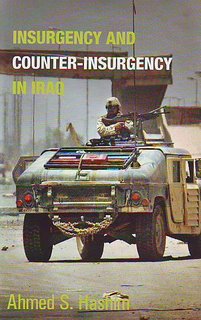
More than two years after the U.S. invasion of Iraq, a loosely organized insurgency continues to target American and Coalition soldiers, as well as Iraqi security forces and civilians, with devastating results. In this sobering account of the ongoing violence, Ahmed Hashim, a specialist on Middle Eastern strategic issues and on irregular warfare, reveals the insurgents behind the widespread revolt, their motives, and their tactics. The insurgency, he shows, is not a united movement directed by a leadership with a single ideological vision. Instead, it involves former regime loyalists, Iraqis resentful of foreign occupation, foreign and domestic Islamist extremists, and elements of organized crime. These groups have cooperated with one another in the past and coordinated their attacks; but the alliance between nationalist Iraqi insurgents on the one hand and religious extremists has frayed considerably. The U.S.-led offensive to retake Fallujah in November 2004 and the success of the elections for the Iraqi National Assembly in January 2005 have led more "mainstream" insurgent groups to begin thinking of reinforcing the political arm of their opposition movement and to seek political guarantees for the Sunni Arab community in the new Iraq.
Hashim begins by placing the Iraqi revolt in its historical context. He next profiles the various insurgent groups, detailing their origins, aims, and operational and tactical modi operandi. He concludes with an unusually candid assessment of the successes and failures of the Coalition's counter-insurgency campaign. Looking ahead, Hashim warns that ethnic and sectarian groups may soon be pitted against one another in what will be a fiercely contested fight over who gets what in the new Iraq. Evidence that such a conflict is already developing does not augur well for Iraq's future stability. Both Iraq and the United States must work hard to ensure that slow but steady success over the insurgency is not overshadowed by growing ethno-sectarian animosities as various groups fight one another for the biggest slice of the political and economic pie.

In place of sensational headlines, official triumphalism, and hand-wringing, Insurgency and Counter-insurgency in Iraq offers a clear-eyed analysis of the increasingly complex violence that threatens the very future of Iraq.
About the Author
Ahmed S. Hashim is Professor of Strategic Studies at the U.S. Naval War College. His previous books include Iran: Dilemmas of Dual Containment and Iraq: Sanctions and Beyond, both written with Anthony H. Cordesman.
Lt. General William E. Odom--
For anyone who doubts that the Vietnam case is instructive for understanding the Iraqi case, I recommend Ahmed S. Hashim's recent book, Insurgency and Counterinsurgency in Iraq. A fluent Arab linguist and a reserve US Army colonel, who has served a year in Iraq and visited it several other times, Hashim offers a textured study that struck me again and again as a re-run of an old movie, especially where it concerned US training of Iraqi forces.
No comments:
Post a Comment